#Earth Core Rigel
Explore tagged Tumblr posts
Text
Prompt 291
You know what? I’m feelin’ a Prompt with the whole halfa family, all the clones and everything.
See, Danny? He’s grown up, he’s moved out, started looking at colleges himself after spending a few years travelling and learning about himself without the threat of a ghost attack.
He’s kept in touch with his friends, both living and dead, and ignores Vlad for the most part now that they’ve reached a truce of sorts, and honestly? He’s just living his life.
But see, it’s kind of hard to figure out what college to pick, with his admittedly not-great choices. Look, he might have a new-ish ID but he’s still visibly not exactly human (though thankfully doesn’t have to worry about the GIW after a… summer activity that ended with several missing buildings)
And most people he goes to? Finds him ‘too unsettling’ which excuse him?? How is he unsettling? He’s a twenty-five year old with six kids ranging from one to six! How is that “scary” huh? Ancients, and all this is making him use the cash he’s saved up over time.
And then- as though all of this isn’t stressful enough and he’s not genuinely worried that he won’t have enough money to feed the kids if he goes to school- a hero nearly trips over Jordan and starts freaking out. He is so fucking done.
#DCxDP#Prompts#DPxDC#Mom Danny#Dad Danny#He’s both#Space Core Danny#Sun Core Dan#Moon Core Ellie#Why yes he named his clone-sons after stars#Shadow Core Orion#Bed Sheet Ghost#Earth Core Rigel#Monster Ghost#Light Core Algor#Tiny Ghost#Ice Core Draco#not ghost king danny#danny fenton clones#de aged dan#de aged ellie#adult danny#Which hero with future knowledge stumbles across baby destroyed-the-world-threat?#Wonderful question and go wild with it#Danny just wants to go to college he’s spent so long saving up so he wouldn’t have to use other’s money for it#He’s THIS close to accepting that villain college invitation that he got from Sam talkin about him#”Oh I’m talkin’ to my ex- he just finished destroying a secret government branch look at the sweet crater- he’s askin if we wanna use it fo#for a garden or something what do y'all think"#”Oh yeah those are his kids aren’t they adorable? Yeah he had them with our other ex- no not that one- the hero one- no the other hero one”#It’s an inside joke but the other villain college people do not know that it’s a joke
1K notes
·
View notes
Text
XAVIER: THE SUN
Xavier is the sun, but not in the way people think. People hear "sunshine character" and think of clear skies during spring. Of flowers and beaches and singing birds. But that's not Xavier. Xavier is the sun in a different way.
(This is all based on my own knowledge/memory of stars, and it's probably not perfectly accurate because I tend to forget things quickly. I'm also oversimplifying and heavily romanticizing this. This is not an academic paper. It's a silly little post about Love and Deepspace!)

The sun is an average size star compared to other stars in the universe. There are billions of smaller stars and billions of larger stars. Compared to stars like Rigel and Betelgeuse, the sun is just a speck of dust in space, and stars like Teegarden's Star and other red dwarfs are grains of sand compared to the sun. It's not particularly special in size.
It's classified as a yellow dwarf star. Yellow dwarf stars don't "go supernova". They don't turn into black holes or neutron stars. They are simply too small.
They burn out of their hydrogen supply over millions of years, collapse, then expand, turning into "red giants". They stay that way until they become unstable, shedding their outer layers in form of large clouds made up of dust and gas (called planetary nebula).
What is left afterwards is the core, a white dwarf. White dwarfs are very dense and do not produce heat. Instead they spend millions of years slowly cooling down. When they completely cool down they turn into black dwarfs, but we will never see one because the universe isn't old enough for a white dwarf to completely cool down and actually turn into one.
It's not special. Even its death will be slow and anticlimactic. It won't collapse into a supermassive black hole after a giant supernova. It will just fade away slowly and quietly after its life as a red giant is over.
What makes the sun special is not itself, but its perfect proximity to earth. The sun makes life here possible because its mass and distance to our home planet gave us a chance to exist and observe it. Nothing else. It is perfectly average in its size, luminosity, and mass.
The sun is also lonely. More than half of the stars that we have observed share a solar system with at least one other star. They orbit each other as they travel through the universe. We can also observe triple star systems (the nearest star to the sun, Proxima Centauri, is part of a triple star system as far as I remember), quadruple systems, and possibly even septuple star systems (Nu Scorpii and AR Cassiopeiae). I've even seen things about possible octuple and even nontuple star systems.
But the sun is alone. It has a lot of planets surrounding it, but no other stars accompany it. There's a chance that it has siblings though, stars that formed in the same nebulae/gas cloud, but we have trouble finding them because we don't even truly know in what nebulae the sun was "born" in.
We have theories, but it's hard to do anything except guess because our sun is quite old and therefore far away from its birthplace (which has probably stopped existing by now). We're looking for stars with similar compositions and ages as our sun, and we look at their orbits and compare them to the orbit of our sun to see if they could be related, all in hopes of finding out more about our star through them, but the search takes a lot of time. We might never find its siblings. Maybe they're just too far away. Or there are no siblings. Maybe the nebulae only gave birth to one star, our sun, and no others.
Maybe our sun was always destined to be alone, from the very beginning of its life to its end. And maybe Xavier is destined to be alone too.
151 notes
·
View notes
Text
- RUNI -
Race Name: Runi Race Nickname(s): N/A Homeworld: Laile
Information One of the primary civilizations in SATIZ-IRATH, the inhabitants of Laile are the descendents of one of the first human expeditions to leave Earth 600 years ago using shuttles that traveled via supercavitation.
The first Runi generation-ships were propelled via supercavitation. Supercavitation utilizes a cavitation bubble to reduce the friction drag on an object to enable high speeds. The shape of the object's nose initiates this bubble. The bubble extends past the aft (back) end of the object, which prevents contact from air or water along its sides. Other advances in Runi spaceflight include hybrid marine and aerospace crafts utilizing electromagnetic fields which create quantum vacuums. This allowed the early prototypes to ignore aerodynamic and hydrodynamic forces, including the craft's inertial mass. Shuttles that do not have soliton cores and are unintended for stellar travel still essentially operate under these basic principles.
Today they are called the RUNI and differ minutely from humans in their appearance, biology and coloring.
Planet
Government: The Confederacy of Laile Environment: H-class (less than 20% surface water - similar to Vulcan or Rigel V) Population: 90 million Capital: Dhavri, Irune Continents: Irune, Mayliz
The Laile Resistance (LR)
Established: 10010 CGE Group: RUNI Leaders: RATAN POLIS, Kaejih Maedaz (POW), Sanew Hishij (DEC). Headquarters: Meili, Irune Size: 13,200 (10220 CGE) Allies: Regional militia groups Opponents: Iro Provisional Militia, Iro Corporate Congress, Laile Armed Forces, the Armed Forces of SATIZ-IRATH, Protocol for the Cessation of Armed Conflict in Satiz-Irath (CACSI)
THE SATIZ-IRATH STAR SYSTEM IS IN THE MILKY WAY GALAXY, 5.025 PARSECS (16 LIGHT-YEARS) FROM EARTH. A PARSEC IS APPROXIMATELY 3 LIGHT YEARS, SO 5 X 3 = 15. HOWEVER, CORRECT INTERSTELLAR NOTATION IS KNOWN BY THE ACRONYM CISR - COMMON INTERSTELLAR REDSHIFT - FOR THE DISTANCE OF AN OBJECT. CISR IS INTELLIGIBLE BY A WIDE VARIETY OF ALIEN NUMERIC SYSTEMS AND DOES NOT RELY ON VARIABLES RELATIVE TO SPECIFIC STAR SYSTEMS (SUCH AS THE SUN).
A non-Federation race (and with little interest in joining the Federation), they made their home in the habitable star-system of SATIZ-IRATH. Their culture has diverged significantly from humanity, as has their genetic structure - more closely resembling Orions than humans. Their world, LAILE, is M3 (Mass Differential 3). which has resulted in adaptations to their musculoskeletal system to withstand the high-atmo. LAILE is M3. This means the field of gravity on Laile is 3x stronger than Earth's. The first expedition to land there required technological adaptation to survive, but over the past 600 years they have begun to evolve a much denser skeletal system (through intentional genetic engineering as well as intermixing with the local Animan Orion [M4] population) and more robust cardiac efficiency.
Technology exists to allow those from M1 and G-class (such as Earth) planets to visit those who diverge significantly more easily, in the form of temperature regulator chips embedded under the skin and gravity equalizer bracelets.
These all operate under the principle of inertia negation, which reduces the wearer's mass to their-normal whilst on the surface of a highly pressurized atmosphere. Planets like Ajilasi Prime (M4) would kill a person who was not wearing a bracelet in short order, as they would very quickly develop the symptoms of crush syndrome. Some people undergo neuromuscular augmentation therapy if they plan on living and working permanently on a disparate MD-world. A mass differential is measured by the variances in newtons per kilogram (N/kg) of a planet's gravity field which is solved by weight divided by mass (mass is solved by volume x density.) Earth's gravity field is 10 N/kg, IRO's gravity field is 20 N/kg, LAILE is 30 N/kg et cetera (these are rounded numbers).
Another factor of their deviations from us is the proliferation of the tropane alkaloid anticholinergic drug hishuri that pervades the environment of Laile. The shur, as it is known, causes brilliant blue eyes in long-term users alongside the potential to develop neurological conditions such as Riel's Syndrome - named for Tala Riel, the McKinley specialist who discovered it.
Also known as Medullary Dysregulation Syndrome or MDS. This causes profound changes to the Runi's vision and breathing, categorized by 3 symptom clusters: agonal breathing, bilateral heterochromic iridocyclitis and stromal apathy, and sleep disturbances. Many also report seizures and cluster headaches. Those who become dependent on hishuri often require Synapse implants to function - these regulate baser functions of breathing and sleeping. The use of hishuri came at a time when the planet was under brutal siege, and every single man, woman and child was required to fight.
For a time their identities were rooted in war and struggle, which eventually took a turn for the worse - one Runi, RATAN POLIS, was unsatisfied when Laile unified and believed it was a sign of weakness. Recruiting from pools of the poor and destitute, orphans and abandoned-ones, he founded the Laile Resistance (LR).

(RATAN POLIS) RATAN POLIS was arrested in 2383 during a visit to Kolar – the Orions handed him over for a significant sum - and during the Interstellar Criminal Court's landmark Federation v. Polis case, he was sentenced to Aoraki Penal Commune in New Zealand, a Special Forensic Unit for violent offenders of his caliber.

(KARIJIN "JIRAN" KELA) Culture Much of Laile is locked in struggle, a desert world with poor surface resources but rich oil deposits, the Iro Corporate Congress (comprised of the Aven people) have waged war against the primary inhabitants for many years.
This has created something of a warrior ethos for the older stratos of Runi, but most young Runi are disillusioned by and therefore abrasive about these things. Within the last half of the 2380s-early 90s, a subculture of Runi has emerged focused on political activism, pacifism, mutual aid and protesting, originating within Kada musical spheres.
Technology The Runi are warp capable. They use soliton drives (described below). They have a lower level of orbital technology, primarily hoppers that require maintenance over time as they're broken-down and second-hand. They use Active Denial Rifles as their primary form of weapon, some units in the Laile Resistance use ion spears. The primary currency on Laile is the cuprate diamond strip, which is a rare material used to create superconductors and reinforce soliton drives.
"Look, Tarish says it's coffee. Well, coffee-ish. With enough caffeine to kickstart a cemetery. I am 100% behind this beverage," he's saying. "OK, so an FTL drive - it's not traditional faster-than-light, either, which was my huge gripe with this, for the record. It uses these things called solitons, which are a wave that maintain shape and energy while moving at constant velocity - it's the shit Lentz posited, that hyper-fast soliton solutions exist within general relativity, and these solitons are maintained integrally by cuprate diamond crystallization - literal superluminal motion enabling objects within the 'wave' to be shielded from tidal forces." ADR stands for Active Denial Rifle (or ADP, for the smaller hand-pistol variant), and it is a ubiquitous directed energy weapon that uses microwaves to burn a subject's skin via the princple of dialectric heating. Most state and non-state parties (law enforcement, military or otherwise) in Satiz-Irath use variations of this weapon, as it provides unparalleled control. This weapon can either be lethal (causing heating past the point of human tolerance) or non-lethal (causing first or second-degree burns) depending on the power of the beam and the length of time it is fired.
species by @gnosticpriesthood !
2 notes
·
View notes
Text
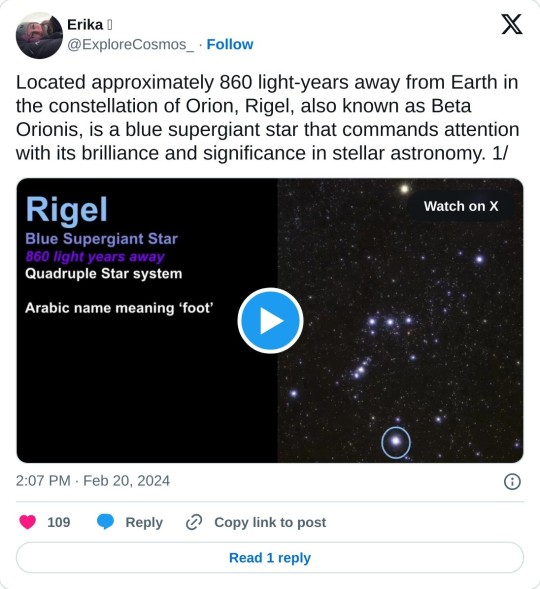
@ExploreCosmos_: Rigel is the brightest star in the constellation of Orion and the seventh brightest star in the night sky. Its name originates from the Arabic word for "foot" or "leg," reflecting its position as the foot of Orion, the mighty hunter of Greek mythology. 2/ With a visual magnitude of about 0.13, Rigel shines fiercely, illuminating its surrounding cosmic neighborhood. Rigel belongs to the spectral class B8Ia, indicating that it is a massive, luminous star with a surface temperature of approximately 11,000 Kelvin. 3/It is estimated to be around 21 times the mass of the Sun and roughly 78 times its radius. Such immense proportions classify Rigel as a blue supergiant. Rigel's luminosity is staggering, with a brightness approximately 120,000 times that of the Sun. 4/Being a blue supergiant, Rigel burns through its nuclear fuel at a rapid pace. As a result, it has a relatively short lifespan compared to smaller, less luminous stars. Estimates suggest that Rigel is only a few million years old & is already nearing the end of its life cycle. 5/ Rigel does not exist in isolation; it is part of a larger stellar system that adds complexity and intrigue to its celestial narrative. Rigel has a companion star, Rigel B, which is often overlooked due to the brilliance of its primary counterpart. 6/Rigel B is itself a spectroscopic binary system, consisting of two stars orbiting around a common center of mass. These stars are likely smaller and less massive than Rigel A, contributing to the overall dynamics of the system. 7/ While no confirmed exoplanets have been discovered in the immediate vicinity of Rigel, astronomers continue to investigate the possibility of planetary companions around this massive star. The intense radiation and stellar winds emitted by Rigel pose challenges for the ... 8/ formation and stability of planetary systems. However, theoretical models suggest that distant gas giants or rocky worlds may orbit within the habitable zone of Rigel, albeit under extreme conditions. 9/Rigel's radiance also illuminates the surrounding interstellar medium, shaping intricate structures such as the Witch Head Nebula. This nebula, located approximately 900 light-years away, reflects the intense ultraviolet radiation emitted by Rigel, creating a ... 10/ stunning cosmic vista for observers on Earth. Rigel's prominence extends beyond its celestial beauty; it serves as a crucial object of study for astronomers seeking to unravel the mysteries of stellar evolution, nucleosynthesis, and the dynamics of stellar systems. 11/ As a blue supergiant approaching the later stages of its life, Rigel offers valuable insights into the fate of massive stars. Scientists observe its behavior to understand processes such as core fusion, mass loss, and eventual supernova explosions, ... 12/which enrich the cosmos with heavy elements essential for the formation of new stars & planetary systems. We employ a variety of observational techniques, including spectroscopy & photometry, to analyze Rigel's spectrum, luminosity variations & physical properties. These observations deepen our understanding of stellar atmospheres, interior structure, and evolutionary pathways, contributing to broader theories of stellar evolution and galactic dynamics. 14/ With advancements in astronomical instrumentation and space exploration technology, researchers anticipate further discoveries and insights into the Rigel system. Future missions may include detailed spectroscopic studies, direct imaging of potential exoplanets, ... 15/and enhanced simulations to model the complex interactions within this dynamic stellar environment. Rigel stands as a beacon of cosmic wonder, captivating observers with its brilliance and scientific significance.
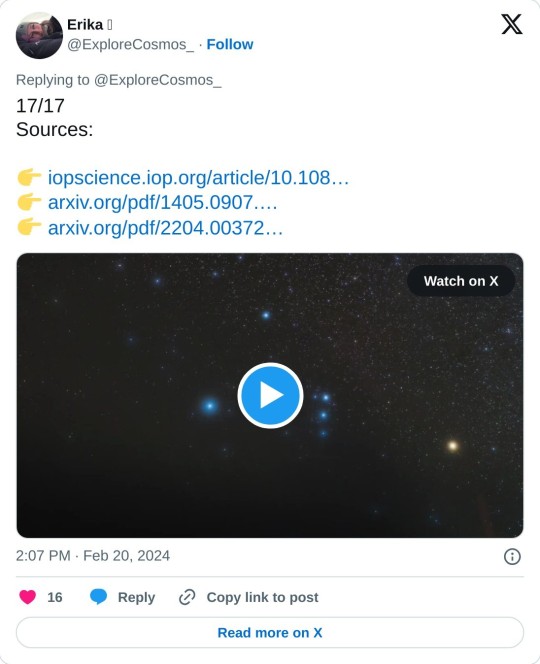
2 notes
·
View notes
Text

Enterprise: Broken Bow (S01E01/02)
My Star Trek-loving polar bear finally convinced me to start watching Enterprise.
A Klingon crash lands in an American cornfield and is injured by a rootin' tootin' gun-tottin' racial stereotype and the Vulcans (who aren't super friendly with proto-Starfleet) recognize the need to return him to his home world. Some arguing happens and Captain Archer gets the job.
Archer collects Funny Doctor Guy then heads to Brazil a Southern Californian park to collect Hot Asian Girl. For vastly different reasons, these are my two favorite characters. T'Pol, a Vulcan lady is also assigned, there's some flaccid speech and we get underway.
Enroute, the ship is attacked by Suliban, some new aliens, and the Klingon is taken. We go to Rigel where Archer meets a Suliban lady who explains the central plot: some of her people are taking orders from ~SpoOooky Future Man~ who intends to start a civil war within the Klingon Empire. They track a Suliban ship to another planet where they steal the Klingon back. They return him to his home world, everyone hugs, and T'Pol stays on the ship.
Well, for starters, it's unclear what the show is trying to be. There's new aliens like the Suliban, but the plot revolves around the Klingons. We get an entirely new ship, but its color design and hull is reminiscent of the Enterprise-E. We get a new crew, but the core trio is an all-American boy scout, a Southern gentleman, and a cold and logical Vulcan. Is this just more of the same, or is it supposed to be something different?
The Enterprise and its technology is less advanced, but not in any substantial way. The ship is limited to warp 4.5, but can still zip around in a blink of an eye. There's no tractor beam, but there's a grappling hook which serves the same function. There's "phase pistols", which... are just phasers. The climax hinges on using the transporter, and while the script enjoys reminding us throughout the episode that it can't be trusted, it works just fine in the end. It's pretty hard to get excited for a resolution that relies on a familiar Star Trek staple...
It seems like Broken Bow handicaps the show's premise (Voyager-style, baby!) by starting just far enough into the future that war, hunger, and disease are already a thing of the past. We start from a point where Earth is unrecognizable. We have no chance to investigate the transition. The juicy questions raised by the premise have already been dismissed by the end of Broken Bow's 90 minutes of runtime. (Voyager-style!)
Instead, the show seems more interested in the humanity side of this period. About exploring how people went from savage barbarians to the enlightened individuals of Roddenberry's Trek. But if that's the intent, there's some problems with that. Namely, that the characters in Roddenberry's Trek were far from ideal humans. If the show intends to connect the dots of "savage barbarian" to "enlightened individual", then it's operating from a mistaken assumption. The humans in Starfleet are composed of people just as human as Archer and his officers (and will continue to be so into this universe's future). There's no room for growth.
Also, just gonna point this out, but the casting is predominantly white, making the show feel strangely more dated than TOS. There's only two alien crew members (T'Pol and the doctor), but both are identifiably Caucasian. Then there's only two characters of color. One, Hoshi Sato, is a Japanese character played by a Korean actress. The second is Token Black Guy. One is the translator and the other flies the ship, which is an inversion of the roles of the only non-white characters on TOS.
But hey, at least they get first names... Unlike poor Sulu who had to wait until Star Trek VI or Uhura who had to wait until JJ Abrams could use millions of dollars to make an in-universe joke about it. Wow, remember JJ Abrams? Whatever happened to that guy? Did everyone finally realize what a talentless hack he was the entire time?
Hoshi gets the very-important role of being helpless, jumping at strange noises, and generally being useless in anything other than linguistics. At one point she needs to be saved from danger by her physically stronger, male protectors. Thanks show. Nice reminder of Asian girl stereotypes there.
The casting just feels regressive, even for 2001, and the xenophobic attitudes about the Vulcans doesn't help matters. Even if humanity is flawed and maybe not quite ready to explore the stars, it doesn't work to convey that idea by portraying humans as intolerant bigots. Going from "racist" to "not racist" just isn't as satisfying as going from "flawed human" to a "enlightened individual".
Ah... I did like the notion that humans and Vulcans don't get along, since it makes logical sense that two different species with vastly different experiences and sensibilities will naturally have points of conflict, but it also operates on yet another misconception about Star Trek, namely that Vulcans and humans later become the bestest of best friends. That idea should really begin and end with Kirk and Spock. Captain Solok in DS9 is a bigot, but episodes like Amok Time or Journey to Babel really showcase the "rocky" relationship between the two peoples. Calling attention to it here also raises a few questions, not least of which is "Why are the Vulcans even helping these barbarians?" It seems like they'd be better off without them?
Oh, then there's the gel scene...
Ya gotta know the gel scene...
The premise here is that Trip (a human male) and T'Pol (a female Vulcan) return from an away mission and must rub each other down with disinfectant gel. These are two characters who do not get along, forced to lubricate each other in a dark room wearing nothing but their underwear.
There's a handful of questionable direction choices here, foremost of which is the repeated close-ups of lubricated skin and high-contrast lighting that really accentuates T’Pol’s rock-hard nipples.
The scene doesn't lead anywhere, it's not played for laughs, and it's never mentioned again. Just a lengthy sequence of very professional, highly sexualized touching. Star Trek has never done "sexy" particularly well outside of some TOS and a scattering of episodes in DS9, but... this was just uncomfortably awkward.
Anyways, the episode is fairly well-paced and plotted, with a relatively tight structure. The plot is simple and linear (Archer finds Klingon, loses him, then finds him again), but as the show's pilot, I'll give that gets a pass. Ya don't wanna clog everything up with a convoluted storyline.
In conclusion, Archer is being portrayed as someone jumping at the opportunity to explore the universe, insisting that mankind is capable and ready to do so. A good, interesting direction to take this would be to show just how wrong he is... namely that there are things he's not ready to deal with. While we get a little bit of that here—the Klingon is taken from his own ship right under his nose and he gets himself shot and incapacitated in the rescue attempt—it doesn't really try to explore the idea, despite the script making a continual effort to show us how eager humans are to meddle in affairs they don't understand.
My enjoyment: 3/5
Also, the opening montage is cringy, the painful pop music overlaid atop an American-centric vision of the space race. I’ll be readily skipping that for all future episodes.
1 note
·
View note
Text
Posted Cards Master Post - 40.33
October 2022, 6th thru 20th
Gem-Knight Lady Lapis Lazuli
Gem-Knight Lapis
Gem-Knight Lazuli
Gem-Knight Master Diamond
Gem-Knight Obsidian
Gem-Knight Pearl
Gem-Knight Phantom Quartz
Gem-Knight Prismaura
Gem-Knight Ruby
Gem-Knight Sapphire
Gem-Knight Sardonyx
Gem-Knight Seraphinite
Gem-Knight Topaz
Gem-Knight Tourmaline
Gem-Knight Zirconia
Gem-Merchant
Gem-Turtle
Particle Fusion
Pyroxene Fusion
Ritual Beast Ambush
Ritual Beast Return
Ritual Beast Steeds
Ritual Beast Tamer Elder
Ritual Beast Tamer Lara
Ritual Beast Tamer Wen
Ritual Beast Tamer Zerampilica
Ritual Beast Tamer Zefrawendi
Ritual Beast Ulti-Apelio
Ritual Beast Ulti-Cannahawk
Ritual Beast Ulti-Gaiapelio
Ritual Beast Ulti-Kimunfalcos
Ritual Beast Ulti-Pettlephin
Ritual Beast's Bond
Spiritual Beast Apelio
Spiritual Beast Cannahawk
Spiritual Beast Pettlephin
Spiritual Beast Rampengu
Spiritual Beast Tamer Winda
Darktellarknight Batlamyus
Satellarknight Alsahm
Satellarknight Altair
Satellarknight Betelgeuse
Satellarknight Capella
Satellarknight Deneb
Satellarknight Procyon
Satellarknight Rigel
Satellarknight Sirius
Satellarknight Skybridge
Satellarknight Unukalhai
Satellarknight Vega
Satellarknight Zefrathuban
Stellarknight Alpha
Stellarknight Constellar Diamond
Stellarknight Delteros
Stellarknight Triverr
Stellarknight Zefraxciton
Stellarnova Alpha
Stellarnova Wave
Tellarknight Genesis
Tellarknight Ptolemaeus
Bi'an, Earth of the Yang Zing
Bixi, Water of the Yang Zing
Chaofeng, Phantom of the Yang Zing
Chiwen, Light of the Yang Zing
Chosen of Zefra
Denglong, First of the Yang Zing
El Shaddoll Anoyatyllis
El Shaddoll Apkallone
El Shaddoll Construct
El Shaddoll Fusion
El Shaddoll Grysta
El Shaddoll Shekhinaga
El Shaddoll Wendigo
El Shaddoll Winda
Helshaddoll Hollow
Jiaotu, Darkness of the Yang Zing
Naelshaddoll Ariel
Nehshaddoll Genius
Nephe Shaddoll Fusion
Pulao, Wind of the Yang Zing
Purushaddoll Aeon
Qadshaddoll Keios
Reeshaddoll Wendi
Resh Shaddoll Incarnation
Shaddoll Beast
Shaddoll Construct
Shaddoll Core
Shaddoll Dragon
Shaddoll Falco
Shaddoll Fusion
Shaddoll Hedgehog
Shaddoll Hound
Shaddoll Schism
Shaddoll Squamata
Shaddoll Zefracore
Shaddoll Zefranaga
Sinister Shadow Games
Suanni, Fire of the Yang Zing
Taotie, Shadow of the Yang Zing
0 notes
Photo
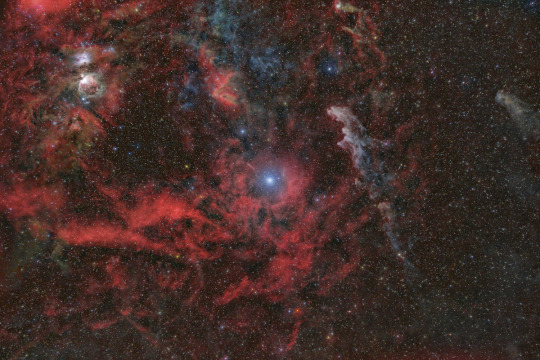
2023 April 7
Rigel Wide Image Credit: Rheinhold Wittich
Explanation: Brilliant, blue, supergiant star Rigel marks the foot of Orion the Hunter in planet Earth's night. Designated Beta Orionis, it's at the center of this remarkably deep and wide field of view. Rigel's blue color indicates that it is much hotter than its rival supergiant in Orion the yellowish Betelgeuse (Alpha Orionis), though both stars are massive enough to eventually end their days as core collapse supernovae. Some 860 light-years away, Rigel is hotter than the Sun too and extends to about 74 times the solar radius. That's about the size of the orbit of Mercury. In the 10 degree wide frame toward the nebula rich constellation, the Orion Nebula is at the upper left. To the right of Rigel and illuminated by its brilliant blue starlight lies the dusty Witch Head Nebula. Rigel is part of a multiple star system, though its companion stars are much fainter.
∞ Source: apod.nasa.gov/apod/ap230407.html
89 notes
·
View notes
Photo
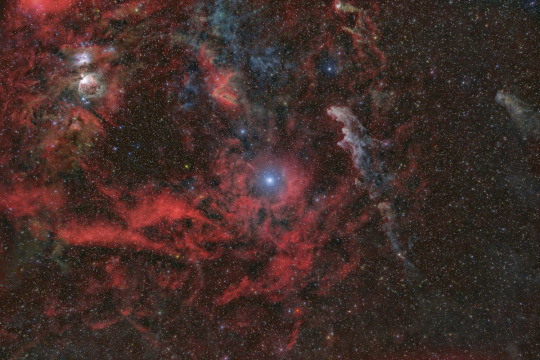
Rigel Wide via NASA https://ift.tt/VKMeUpC
Brilliant, blue, supergiant star Rigel marks the foot of Orion the Hunter in planet Earth's night. Designated Beta Orionis, it's at the center of this remarkably deep and wide field of view. Rigel's blue color indicates that it is much hotter than its rival supergiant in Orion the yellowish Betelgeuse (Alpha Orionis), though both stars are massive enough to eventually end their days as core collapse supernovae. Some 860 light-years away, Rigel is hotter than the Sun too and extends to about 74 times the solar radius. That's about the size of the orbit of Mercury. In the 10 degree wide frame toward the nebula rich constellation, the Orion Nebula is at the upper left. To the right of Rigel and illuminated by its brilliant blue starlight lies the dusty Witch Head Nebula. Rigel is part of a multiple star system, though its companion stars are much fainter.
7 notes
·
View notes
Photo
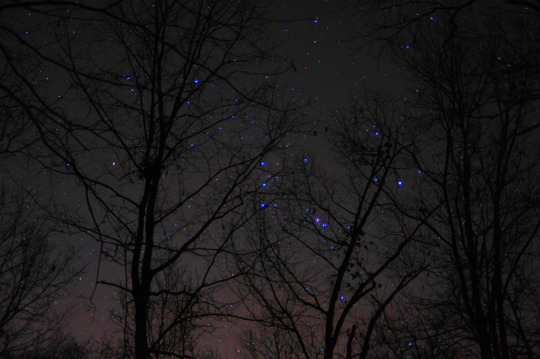
The Fainting of Betelgeuse : Begirt with many a blazing star, Orion the Hunter is one of the most recognizable constellations. In this night skyscape the Hunter's stars rise in the northern hemisphere's winter sky on December 30, 2019, tangled in bare trees near Newnan, Georgia, USA. Red super giant star Betelgeuse stands out in yellowish hues at Orion's shoulder left of center, but it no longer so strongly rivals the blue supergiant star Rigel at the Hunter's foot. In fact, skygazers around planet Earth can see a strikingly fainter Betelgeuse now, its brightness fading by more than half in the final months of 2019. Betelgeuse has long been known to be a variable star, changing its brightness in multiple cycles with approximate short and long term periods of hundreds of days to many years. The star is now close to its faintest since photometric measurements in 1926/27, likely due in part to a near coincidence in the minimum of short and long term cycles. Betelgeuse is also recognized as a nearby red supergiant star that will end its life in a core collapse supernova explosion sometime in the next 1,000 years, though that cosmic cataclysm will take place a safe 700 light-years or so from our fair planet. via NASA
701 notes
·
View notes
Text
Prompt 218
“Moom, there’s yellow-eyed creeps fighting ninjas outside the window again!”
Danny sighed, taking a deep breath- in for ten, out for eight- as he set the pot he was cleaning back in the sink. Dan- currently six- came running in from the living room of the apartment, where he was watching TV. Or he should have been if not for the bullshit outside.
He sighed again, picking up baby Ellie- currently closer to two- out of her highchair (even if she could just float out) and let his oldest drag him to the window. Sure enough, another fight was happening, with no vigilante in sight stopping it. Look, he knew most people didn’t live here, but it was still rude.
“Jordan, remember how I told you how violence isn’t always the answer?” Danny asked sweetly, Dan’s expression shifting to a wicked grin as he opened the window. “Feel free to practice tossing some fireballs while I clean up your sister, yeah?”
Ah, the sweet sound of surprised cursing and startled ecto-signatures. Maybe they’d be polite enough to take their spar elsewhere.
#DCxDP#DPxDC#Danny: I’m going to be a better parent than my parents & not get distracted by work#He has a couple of the clones’ cores too#Does it count as mpreg?#Danny has a garden shop/bookstore at ground level#He’s gotten better at cooking but he doesn’t trust them not to come alive so he sticks to drinks#Halfas are like phoenixes when they have to retreat to their core#They come out as babies thanks to having to rebuild their human flesh body from scratch#Why yes they’re in Gotham- he’s lived in several different cities over the last few decades#Doesn’t look a day over thirty somehow (it’s the ectoplasm)#Space Core Danny#Sun Core Dan#Moon Core Ellie#Why yes he named his clone-sons after stars#Shadow Core Orion#Bed Sheet Ghost#Earth Core Rigel#Monster Ghost#Light Core Algor#Tiny Ghost#Sun Core Draco#Yes Danny is an adult with a pair of small children & 4 more on the way what of it#dad danny#Mom Danny#He is both#prompts
1K notes
·
View notes
Text
The Lives, Times, and Deaths of Stars
Who among us doesn’t covertly read tabloid headlines when we pass them by? But if you’re really looking for a dramatic story, you might want to redirect your attention from Hollywood’s stars to the real thing. From birth to death, these burning spheres of gas experience some of the most extreme conditions our cosmos has to offer.

All stars are born in clouds of dust and gas like the Pillars of Creation in the Eagle Nebula pictured below. In these stellar nurseries, clumps of gas form, pulling in more and more mass as time passes. As they grow, these clumps start to spin and heat up. Once they get heavy and hot enough (like, 27 million degrees Fahrenheit or 15 million degrees Celsius), nuclear fusion starts in their cores. This process occurs when protons, the nuclei of hydrogen atoms, squish together to form helium nuclei. This releases a lot of energy, which heats the star and pushes against the force of its gravity. A star is born.
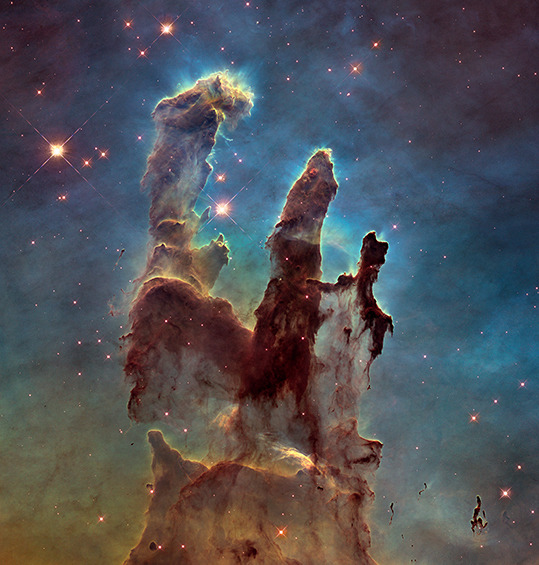
Credit: NASA, ESA and the Hubble Heritage Team (STScI/AURA)
From then on, stars’ life cycles depend on how much mass they have. Scientists typically divide them into two broad categories: low-mass and high-mass stars. (Technically, there’s an intermediate-mass category, but we’ll stick with these two to keep it straightforward!)
Low-mass stars
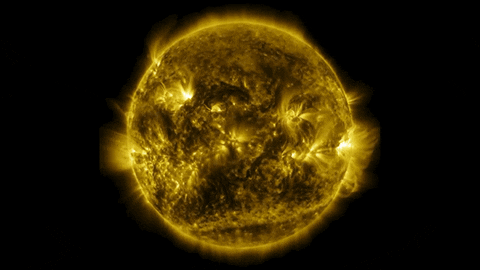
A low-mass star has a mass eight times the Sun's or less and can burn steadily for billions of years. As it reaches the end of its life, its core runs out of hydrogen to convert into helium. Because the energy produced by fusion is the only force fighting gravity’s tendency to pull matter together, the core starts to collapse. But squeezing the core also increases its temperature and pressure, so much so that its helium starts to fuse into carbon, which also releases energy. The core rebounds a little, but the star’s atmosphere expands a lot, eventually turning into a red giant star and destroying any nearby planets. (Don’t worry, though, this is several billion years away for our Sun!)

Red giants become unstable and begin pulsating, periodically inflating and ejecting some of their atmospheres. Eventually, all of the star’s outer layers blow away, creating an expanding cloud of dust and gas misleadingly called a planetary nebula. (There are no planets involved.)
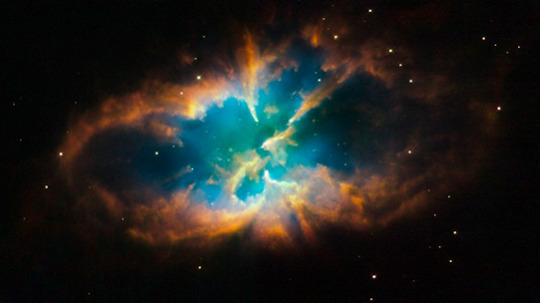
Credit: NASA, ESA, and the Hubble Heritage Team (STScI/AURA)
All that’s left of the star is its core, now called a white dwarf, a roughly Earth-sized stellar cinder that gradually cools over billions of years. If you could scoop up a teaspoon of its material, it would weigh more than a pickup truck. (Scientists recently found a potential planet closely orbiting a white dwarf. It somehow managed to survive the star’s chaotic, destructive history!)

High-mass stars
A high-mass star has a mass eight times the Sun’s or more and may only live for millions of years. (Rigel, a blue supergiant in the constellation Orion, pictured below, is 18 times the Sun’s mass.)
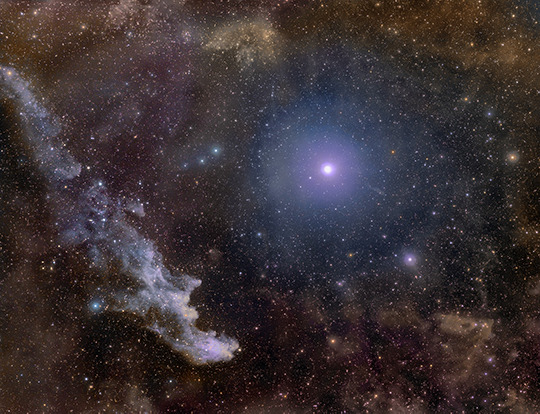
Credit: Rogelio Bernal Andreo
A high-mass star starts out doing the same things as a low-mass star, but it doesn’t stop at fusing helium into carbon. When the core runs out of helium, it shrinks, heats up, and starts converting its carbon into neon, which releases energy. Later, the core fuses the neon it produced into oxygen. Then, as the neon runs out, the core converts oxygen into silicon. Finally, this silicon fuses into iron. These processes produce energy that keeps the core from collapsing, but each new fuel buys it less and less time. By the point silicon fuses into iron, the star runs out of fuel in a matter of days. The next step would be fusing iron into some heavier element, but doing requires energy instead of releasing it.
The star’s iron core collapses until forces between the nuclei push the brakes, and then it rebounds back to its original size. This change creates a shock wave that travels through the star’s outer layers. The result is a huge explosion called a supernova.

What’s left behind depends on the star’s initial mass. Remember, a high-mass star is anything with a mass more than eight times the Sun’s — which is a huge range! A star on the lower end of this spectrum leaves behind a city-size, superdense neutron star. (Some of these weird objects can spin faster than blender blades and have powerful magnetic fields. A teaspoon of their material would weigh as much as a mountain.)
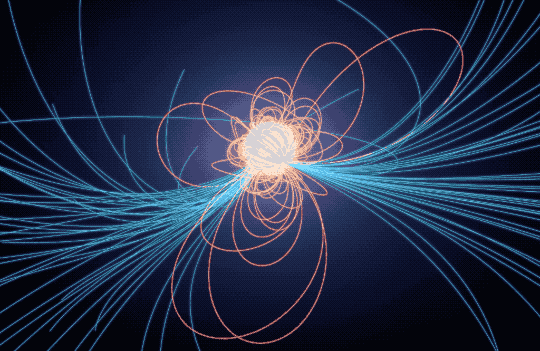
At even higher masses, the star’s core turns into a black hole, one of the most bizarre cosmic objects out there. Black holes have such strong gravity that light can’t escape them. If you tried to get a teaspoon of material to weigh, you wouldn’t get it back once it crossed the event horizon — unless it could travel faster than the speed of light, and we don’t know of anything that can! (We’re a long way from visiting a black hole, but if you ever find yourself near one, there are some important safety considerations you should keep in mind.)
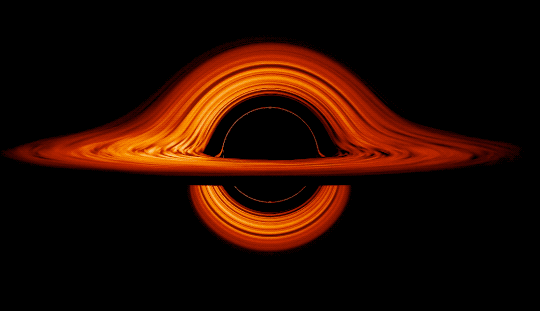
The explosion also leaves behind a cloud of debris called a supernova remnant. These and planetary nebulae from low-mass stars are the sources of many of the elements we find on Earth. Their dust and gas will one day become a part of other stars, starting the whole process over again.
That’s a very brief summary of the lives, times, and deaths of stars. (Remember, there’s that whole intermediate-mass category we glossed over!) To keep up with the most recent stellar news, follow NASA Universe on Twitter and Facebook.
Make sure to follow us on Tumblr for your regular dose of space: http://nasa.tumblr.com.
4K notes
·
View notes
Video
vimeo
Magnificent timelapse work with the night sky. Original caption below with many more details:
As the days shorten and the darkness progressively eats away the light, an amazing transformation happens in the northern hemisphere skies. A lot of astronomers and stargazers prefer summertime to look up at the stars, probably because conditions are better and the brightest part of our own galaxy, the milky way is more visible, even with the naked eye. Although fainter, the ‘winter’ part of the milky way and the rest of the winter sky harbor countless unsuspected gems, if one knows how to find and capture them!
In the late Fall, you can still get a glimpse at the bright core of our galaxy sink down under the horizon just after sunset, along with its dark hydrogen gas lanes, Lagoon and trifid nebulae, and Saturn. Later, you can catch Scutum (shield constellation) and its dark nebulosity set in the south west/west. In the movie, this part is visible in many scenes but my favorite one is by far as it sets on La Palma shores behind a thunderstorm accompanied by red sprites, airglow and zodiacal lights.Then, take a peek at one of my favorite areas of the winter sky: the Swan constellation. I presented it to you (also on the cover), so that you can see it from different perspectives, but the best is probably at a narrower angle to show the beautiful magenta colors of the H-alpha emission nebulae (North-American, Pelican, Sadr region or IC 1396). I also included a scene where the ‘Summer Triangle’ of Cygnus (formed by Deneb, Sadr, Delta Cygni, and Gienah) is photobombed by an overhead aurora borealis. Continuing along the winter milky way, I included a shot of the Heart and Soul nebula. Rising on the other side of the hemisphere, we are now looking at the outer edge of our galaxy, where very little light comes from fewer stars, nebulae and dark clouds (in comparison to the core!). I wanted to show you a very novel scene combining the hot Pleiades stars reflecting their blue light onto passing gasses and the California nebula glowing blood red! The next area I want to emphasize is winter’s most emblematic: Orion. I wanted to maximize the different colors and brightness this constellation has to offer while shooting it in a series of single shots: the orange of Betelgeuse and the blue of Rigel, the gigantic red-glowing Barnard’s loop, the inevitable shell-like Orion nebula along with the running man nebula, the horse-head nebula, the flame nebula, Lambda Orionis nebula… Further away from the winter milky way doesn’t mean dull at all, au contraire! Look at the magnificent Andromeda galaxy (M31), the size of 6 full moons- rise above the tree line! What about the iconic Big Dipper being photobombed by some pillars of Icelandic and Canadian aurora borealis? What about these iridescent marbles at the very start of the video? Those are twinkling Sirius, Capella (bottom left) and Vega (upper right) emphasized by the real-time out-of-focus setting to reveal the hypnotic shift in light and colors of these twinkling stars created by our own atmosphere! You will probably miss a lot of night sky events if you only watch the video once! Don’t blink, you might miss a lot of meteors (Perseids, Orionids, Draconids, Leonids…), iridium flares, low-orbit satellites, red sprites. What about those satellites that seem to ‘follow’ each other in some deep-sky scenes? Those are geosynchronous satellites normally hovering over a fixed point of the Earth, but the motion of the star tracker allows them to move whereas the sky is now immobile. I am sure professionals and amateurs will spot many more features, all you have to do is sit back and gaze!
The goal of this series of astro-lapses ‘Galaxies’ and especially this second opus was a way for me to push the limits of single astrophotography. However beautiful and numerous they are, wide-angle shots of the milky way moving against a foreground became less interesting to me as I got to shoot more and more astro-timelapses. I became more interested in exploring the possibilities that modern lenses, sensors and techniques could give, so I started using medium-format and astromodfication to take advantage of a wider light spectrum and show the red colors of H-alpha emission nebulae that are so ubiquitous in the winter part of the sky. I also wanted to improve the quality of the shots, so I used a square light pollution filter for shots at more than 50mm (Lonely Speck’s Pure Night LP filter), and a star tracker for some of the scenes to increase sharpness and details (Vixen Polarie). It was very important for me to prove that deep-sky time-lapses can be very interesting and successful, whether they hold a foreground or not, because so many things can be happening the sky (airglow, meteors, satellites, haze giving a temporary glow to the stars…). All shots have been recorded over the past year and in different countries (France, Switzerland, Spain, Iceland, Denmark and Canada). I will gladly give more details upon request. Thanks a lot for watching!
#timelapse#night sky#galaxy#astronomy#dark sky#satellite#meteor#sprite#milky way#video#vimeo#the universe#the real universe
58 notes
·
View notes
Text
stars; an introduction~
a/n- this is literally just some notes that i’ve taken from the book “astronomy” by mark garlick
WHAT IS A STAR?
stars- glowing, ionized orbs of gas (mainly helium and hydrogen)
gravitational contraction- process where stars shrink under their own weight and mass
protostar- dense blob of gas inside a nebula, the star before nuclear reactions begin
OVERVIEW
stars form in nebulae, large cocoons of cloud filled with planet/star building materials. the protostars are made from stolen gas from other nebulae, and slowly build their mass until nucleic reactions begin in the core, thus creating a star.
these nucleic reactions fuse hydrogen nuclei and create helium.
they push pressure out of the core, which goes to the outer edges of the star, thus creating a balance between the star and the crushing gravity surrounding it.
STAR SIZE, TEMPERATURE, AND TYPES
star color depends on size- the bigger the star, the more heat capable of being stored.
the sun, despite being the center of our solar system, is not the brightest nor largest star in our galaxy.
one blue star, rigel, is as bright as 150,000 suns.
antares, a red supergiant, the biggest type of star makes rigel seem like a bouncy ball, measuring up at 700 times the sun’s diameter. however, antares is less than one-millionth of the sun’s density.
red dwarfs are smaller and cooler than the sun and are the most common star.
white dwarfs are even smaller, however, all are still larger than earth.
LIFECYCLE OF A STAR
DEFINITIONS
main sequence- long period in a star’s life where the nucleic reactions are converting hydrogen to helium
AGING PROCESS
nucleic reaction fuel grows low
core becomes unbalanced and contracts
core heats up and manages to come back to normal
the energy creating in this process pushes the outer layers farther outward
star becomes a subgiant
this process repeats itself, and the star goes from subgiant > red/supergiant > white dwarf > neutron star/black hole
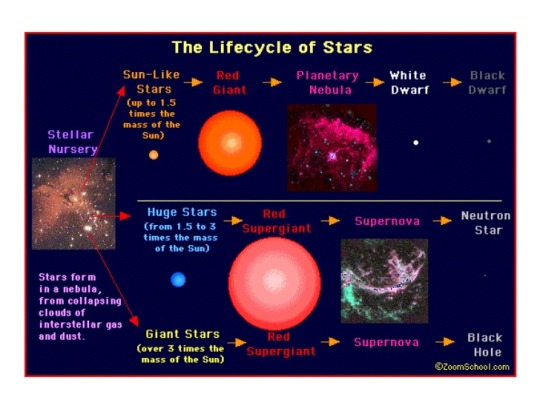
BINARIES, MULTIPLES, AND VARIABLES
DEFINITIONS
binaries- two stars orbiting a common center of mass
double stars- two stars close to each other
novae- stellar eruptions, sometimes caused by a star in a binary drawing too much energy from the other star and collapsing in on itself
multiple (systems)- binaries with 3+ stars
variable- star that changes brightness
eclipsing variables- stars that change brightness by moving behind or in front of another star
intrinsic variables- stars that change brightness by pulsing and erupting
binaries/multiple are extremely common, considering that the interstellar gas cloud (nebula) that stars form from has so much mass it can create more than one star.
binaries draw mass from each other.
brightness depends on surface area- the bigger the star, the more heat it can produce, therefore the more vibrant it becomes.
ALGOL SYSTEM
this chart shows how the brightness in eclipsing variables change.
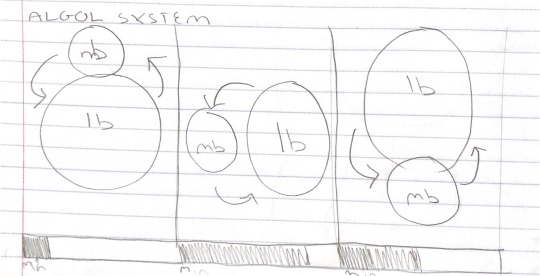
*lb is less bright star, mb is more bright star (amazing labels i know.)
**the filled in/empty graph panels at the bottom are the brightness meters. the more shaded-in each one is, the more bright the binary is.
STAR CLUSTERS
globular clusters- big (like as big as a small galaxy), spherical star clusters filled with old and red stars
open clusters- a disconnected, small amount of young stars bound by gravity inside of a gas cloud
globular clusters normally form near galaxies or they themselves host galaxies.
globular clusters are elliptical.
the milky way has over 140 globular clusters.
STAR DEATH: PLANETARY NEBULAE
planetary nebulae- death of smaller stars that forms a gas cloud
white dwarf- exposed core of a dead star
black dwarf- dead white dwarf
as a star’s core grows hotter at the end of its life, colorful energy puffs up the star like a big nuclear balloon.
then, (if the star is a red giant) the star will let go of its outer layers, (the energy puff) creating a big cloud of energetic dust filled with planet-making materials.
this dust cloud is called a planetary nebulae.
the remaining core is called a white dwarf, and shines by releasing the left-over energy in the core.
once that dies out, it becomes a black dwarf.
STAR DEATH: SUPERNOVAE
supernovae- explosive death of a big boi star
stellar corpse- neutron star or black hole, what’s left of a dead star
neutron stars- the densest large-scale objects in the universe, have as much mass as an entire solar system
pulsars- neutron stars the rotate at a vicious rate and send out radio waves
SUPERNOVAE: TYPE I
these supernovae come from binary systems.
they happen when a white dwarf draws too much matter from the other star in the system and collapses from the weight of the stolen matter, thus rebounding and destroying itself.
nothing remains of this star death. :(
SUPERNOVAE: TYPE II
this supernovae never involves a white dwarf, only huge stars at least 8x greater than the sun.
it’s just a big explosion after the star runs out of fuel for its core.
supernovae type twos always leave a stellar corpse.
NEUTRON STARS
these stars are self-explanatory- they are made almost completely of neutrons.
the matter (atoms, made with protons, electrons, and neutrons) of a star is broken down by the gravity around it.
this causes the electrons and protons to combine, forming more neutrons, and creating a bunch of fused subatomic particles.
the compression of the matter creates a large magnetic field formed by the energy being pushed out, thus creating pulsars, which can be measured and recorded by scientists, giving them the opportunity to locate neutron stars (they are invisible otherwise.)
STAR DEATH: BLACK HOLES
black hole- place where gravity is so magnified it sucks in everything. imagine this- the world’s gravity becomes too much, so it’s core collapses, sucking everything into one big sink hole.
accretion disk- the remains of star systems eaten by black holes that sit on a supermassive black hole’s rim.
singularity- point of undefined mathematical size where all the matter in a black hole has been compressed into.
black holes are created when a big star dies, leaving a neutron star that is so big and has a magnetic field so large it can not stay balanced and shatters, leaving a single point, the singularity.
all laws of physics have left the chat, only infinite gravity remains.
as you move away from a black hole, the escape velocity drops below that of light, which means nothing can get out- not sound, not light, nothing.
there is a boundary however, which is called the event horizon.
#ahhhhHHHHHHHHHH#asterope#astronomy#stars#black holes#astrology#zodiacs#pisces sun#pisces moon#scorpio moon#aquarius sun#aquarius mercury#aquarius moon#me listing out zodiac placements that would like astrology#aquarius venus#sagittarius sun#sagittarius moon#cancer sun#cancer mercury#scorpio mercury#pisces mercury#december
7 notes
·
View notes
Photo
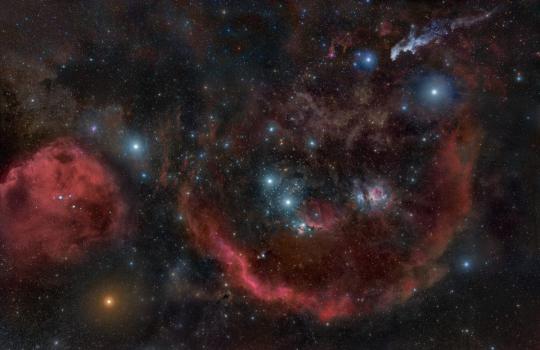
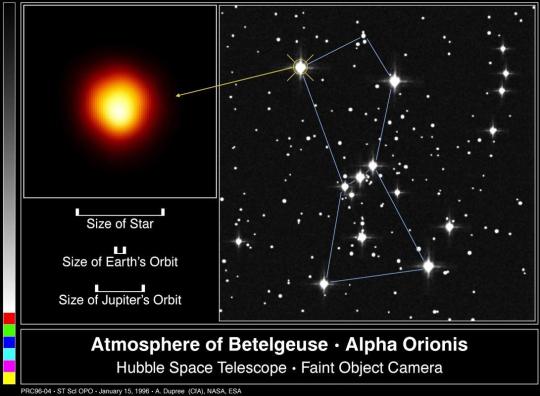
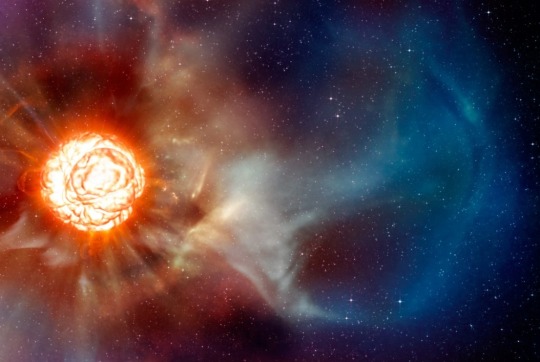
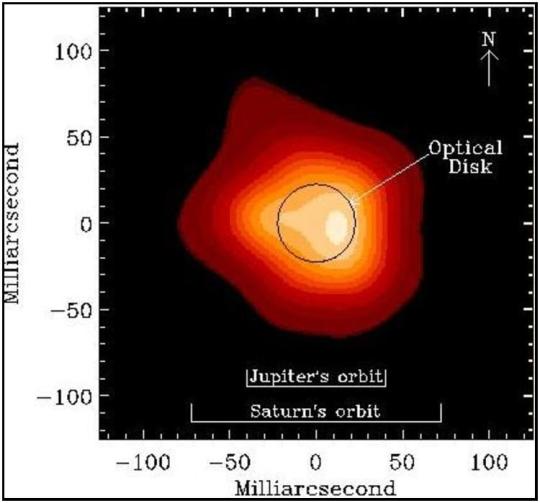
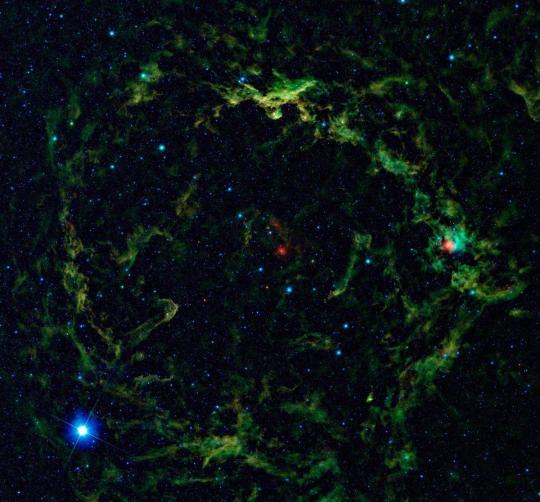
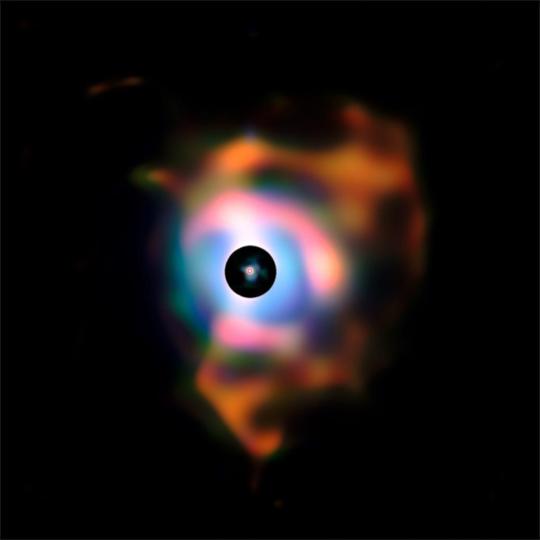


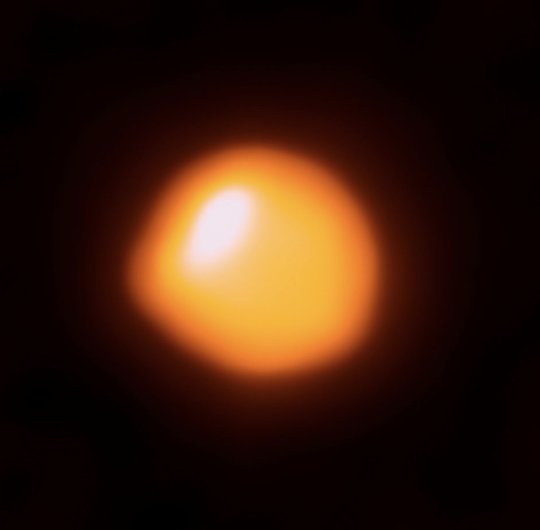

Is Betelgeuse About To Explode?
“Unfortunately, though, the key question of exactly when Betelgeuse is going to go supernova is one that we're not any closer to having an answer to. Until we can measure the processes occurring in the star's core, which would require a neutrino telescope far more powerful than all the neutrino observatories on Earth combined, we cannot know which elements are being fused inside of it.
Right now, our best models are consistent with helium-burning rather than any of the heavier elements, indicating that we have at least hundreds of years — and possibly hundreds of thousands — until the inevitable supernova finally detonates. If you haven't checked out the constellation of Orion recently, though, take a good look and notice how much dimmer red Betelgeuse is than blue Rigel, a severe departure from its past decade of appearances. A supernova may not be imminent, but is sure is fascinating to watch and hope!”
Is Betelgeuse about to explode? Probably not, but we cannot be sure.
Want to know what astronomers know so far? Get the fascinating story today, and go see what it’s doing with your own naked eye!
126 notes
·
View notes
Photo
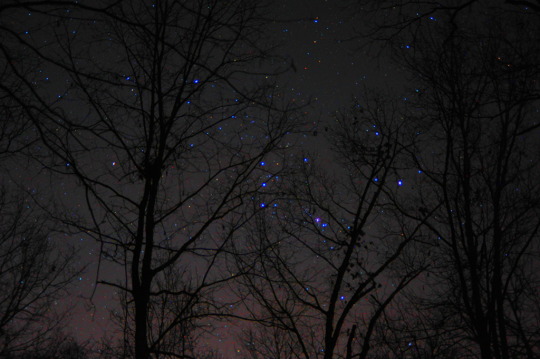
The Fainting of Betelgeuse Image Credit & Copyright: Jimmy Westlake (Colorado Mountain College)
Begirt with many a blazing star, Orion the Hunter is one of the most recognizable constellations. In this night skyscape the Hunter's stars rise in the northern hemisphere's winter sky on December 30, 2019, tangled in bare trees near Newnan, Georgia, USA. Red super giant star Betelgeuse stands out in yellowish hues at Orion's shoulder left of center, but it no longer so strongly rivals the blue supergiant star Rigel at the Hunter's foot. In fact, skygazers around planet Earth can see a strikingly fainter Betelgeuse now, its brightness fading by more than half in the final months of 2019. Betelgeuse has long been known to be a variable star, changing its brightness in multiple cycles with approximate short and long term periods of hundreds of days to many years. The star is now close to its faintest since photometric measurements in 1926/27, likely due in part to a near coincidence in the minimum of short and long term cycles. Betelgeuse is also recognized as a nearby red supergiant star that will end its life in a core collapse supernova explosion sometime in the next 1,000 years, though that cosmic cataclysm will take place a safe 700 light-years or so from our fair planet.
https://apod.nasa.gov/apod/ap200102.html?fbclid=IwAR3OsHHZ7j4FvdkwGmTtu0-6Dxe9lEedYtmjlr_L-QcoMoxidTnYSDfaylE
14 notes
·
View notes
Text
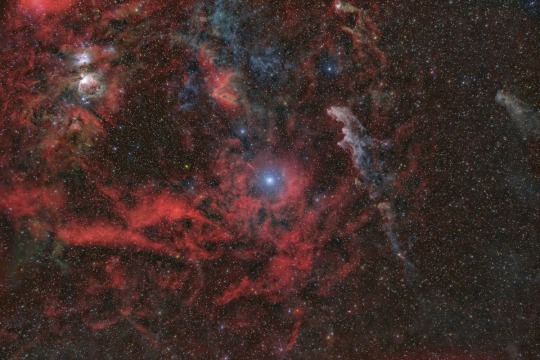
APOD: Rigel Wide (4/7/23) Brilliant, blue, supergiant star Rigel marks the foot of Orion the Hunter in planet Earth's night. Designated Beta Orionis, it's at the center of this remarkably deep and wide field of view. Rigel's blue color indicates that it is much hotter than its rival supergiant in Orion the yellowish Betelgeuse (Alpha Orionis), though both stars are massive enough to eventually end their days as core collapse supernovae. Some 860 light-years away, Rigel is hotter than the Sun too and extends to about 74 times the solar radius. That's about the size of the orbit of Mercury. In the 10 degree wide frame toward the nebula rich constellation, the Orion Nebula is at the upper left. To the right of Rigel and illuminated by its brilliant blue starlight lies the dusty Witch Head Nebula. Rigel is part of a multiple star system, though its companion stars are much fainter.
0 notes